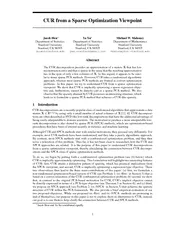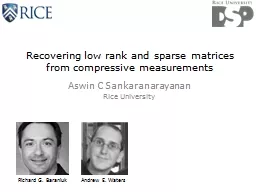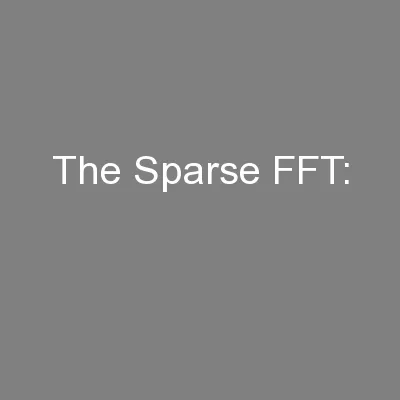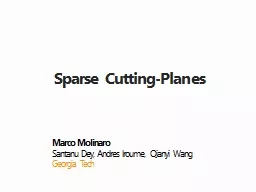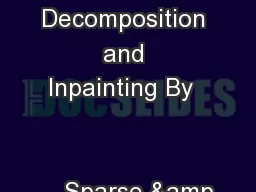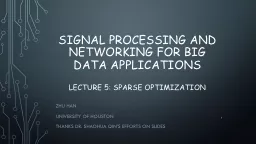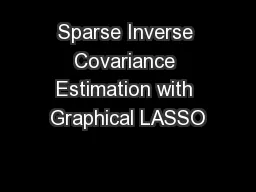PDF-CUR from a Sparse Optimization Viewpoint Jacob Bien De
Author : cheryl-pisano | Published Date : 2015-05-24
edu Ya Xu Department of Statistics Stanford University Stanford CA 94305 yaxstanfordgmailcom Michael W Mahoney Department of Mathematics Stanford University Stanford
Presentation Embed Code
Download Presentation
Download Presentation The PPT/PDF document "CUR from a Sparse Optimization Viewpoint..." is the property of its rightful owner. Permission is granted to download and print the materials on this website for personal, non-commercial use only, and to display it on your personal computer provided you do not modify the materials and that you retain all copyright notices contained in the materials. By downloading content from our website, you accept the terms of this agreement.
CUR from a Sparse Optimization Viewpoint Jacob Bien De: Transcript
edu Ya Xu Department of Statistics Stanford University Stanford CA 94305 yaxstanfordgmailcom Michael W Mahoney Department of Mathematics Stanford University Stanford CA 94305 mmahoneycsstanfordedu Abstract The CUR decomposition provides an approximat. Volkan . Cevher. volkan.cevher@epfl.ch. Laboratory. for Information . . and Inference Systems - . LIONS. . http://lions.epfl.ch. Linear Dimensionality Reduction. Compressive sensing. non-adaptive measurements. Aswin C Sankaranarayanan. Rice University. Richard G. . Baraniuk. Andrew E. Waters. Background subtraction in surveillance videos. s. tatic camera with foreground objects. r. ank 1 . background. s. parse. From Theory to Practice . Dina . Katabi. O. . Abari. , E. . Adalsteinsson. , A. Adam, F. . adib. , . A. . Agarwal. , . O. C. . Andronesi. , . Arvind. , A. . Chandrakasan. , F. Durand, E. . Hamed. , H. . Aditya. Chopra and Prof. Brian L. Evans. Department of Electrical and Computer Engineering. The University of Texas at Austin. 1. Introduction. Finite Impulse Response (FIR) model of transmission media. Tu as écrit sur la ligne.. Tu as bien formé tes lettres.. C’est bien présenté.. Tu as mis les majuscules.. Tu as mis les points à la fin des phrases.. Tu as utilisé les mots de la boite à mots.. Recovery. . (. Using . Sparse. . Matrices). Piotr. . Indyk. MIT. Heavy Hitters. Also called frequent elements and elephants. Define. HH. p. φ. . (. x. ) = { . i. : |x. i. | ≥ . φ. ||. x||. p. Tianzhu . Zhang. 1,2. , . Adel Bibi. 1. , . Bernard Ghanem. 1. 1. 2. Circulant. Primal . Formulation. 3. Dual Formulation. Fourier Domain. Time . Domain. Here, the inverse Fourier transform is for each . Molinaro. Santanu. . Dey. , Andres . Iroume. , . Qianyi. Wang. Georgia Tech. Better . approximation. of the integer hull. CuttinG. -planes. IN THEORY. Can use . any . cutting-plane. Putting all gives . Michael . Elad. The Computer Science Department. The . Technion. – Israel Institute of technology. Haifa 32000, . Israel. David L. Donoho. Statistics Department Stanford USA. . Jeremy Watt and . Aggelos. . Katsaggelos. Northwestern University. Department of EECS. Part 2: Quick and dirty optimization techniques. Big picture – a story of 2’s. 2 excellent greedy algorithms: . Thirty-one pages in the Book of Mormon are in Jacob’s own words.. Born between 600 and 593 BC. . Devastatingly direct. ! . (. Isaiah like!). In fewer than 28 pages, the record from Jacob to Mosiah covers about 421 of the total 1021 years covered by the entire Nephite record (41%). . Applications. Lecture 5. : Sparse optimization. Zhu Han. University of Houston. Thanks Dr. . Shaohua. Qin’s efforts on slides. 1. Outline (chapter 4). Sparse optimization models. Classic solvers and omitted solvers (BSUM and ADMM). J. Friedman, T. Hastie, R. . Tibshirani. Biostatistics, 2008. Presented by . Minhua. Chen. 1. Motivation. Mathematical Model. Mathematical Tools. Graphical LASSO. Related papers. 2. Outline. Motivation. Jacob 6-7 Jacob 6:4 Which characteristic of God seems most dominant in the allegory ? “In his concluding commentary on the allegory, Jacob (said )… How merciful is our God unto us ” (Jeffrey R. Holland,
Download Document
Here is the link to download the presentation.
"CUR from a Sparse Optimization Viewpoint Jacob Bien De"The content belongs to its owner. You may download and print it for personal use, without modification, and keep all copyright notices. By downloading, you agree to these terms.
Related Documents

